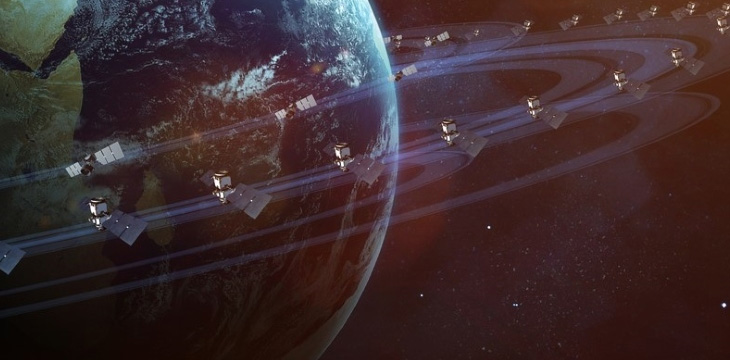
|
Getting your Trinity Audio player ready... |
…and Mars, or anywhere we decide to set up a colony.
SpaceBelt + Arch Mission: preserving human knowledge and taking them wherever we go in space
Cloud Constellation’s mission to shoot data into space through SpaceBelt is the stuff of science fiction. It’s no wonder they’ve quickly captured the imagination of other companies who thought they hold the ultimate time capsule. And it’s not surprising either that apart from starry-eyed sci-fi fans, they’ve also managed to turn heads in the blockchain space. So much so, that they partnered up with SpaceChain last month.
They’re putting highly sensitive data into satellites on low Earth orbit (LEO), where they’re safe from dangers on ground, both physical and digital—breaching satellite-based data is an unknown terrain to today’s hackers.
They recently, brokered an allegiance with yet another organization that is a force to be reckoned with—a company called Arch Mission which has taken up the pledge to preserve human knowledge.
“SpaceBelt offers us another extraordinary opportunity to preserve human knowledge. Cloud Constellation Corporation represents a shift in thinking beyond terrestrial networks and opens up a new, secure frontier for data storage and access that will be vital to the Arch Mission Foundation’s efforts. We’re committed to utilizing new storage and distribution technologies to ensure our archival efforts, and SpaceBelt will be a key component of that,” Nova Spivack, the chairman and co-founder of Arch Mission said in a release.
Dennis Gatens, VP of Channel Management & Marketing at Cloud Constellation, echoes Spivack’s sentiment that the partnership is a perfect match.
“We believe Arch Mission’s vision is a worthy strategy for preserving the world’s knowledge for the benefit of future generations and see Cloud Constellation Corporation’s SpaceBelt secure global connectivity and cloud data storage services as playing an integral role. Utilizing SpaceBelt, our goal is to facilitate secure global collaboration which is necessary in order to achieve their vision to the fullest extent,” Gatens said.
“Further, we believe all partners will have the opportunity to leverage the skills and contributions of each other to enable new and strategic applications in space, such as blockchain- based applications that might ultimately lead to highly secure, immutable storage, transfer of data and associated transactions.”
Taking data to Mars, and wherever else
Having already familiarized myself with SpaceBelt and Cloud Constellation from my previous interview with them, I checked out Arch Mission this time.
“Wherever humans go, so will go the Arch. Wherever the Arch will go, so will go humanity,” Spivack wrote on their website. I wondered: does this mean that if and when the Mars Colony succeeds, that they’ll be there, too?
Gatens thinks so.
“Satellite communications is a fundamental and critical part of the global communications infrastructure, therefore the emergence of cloud services in low Earth orbit (LEO) is a natural evolution,” he said. In fact, it’s not just the end destination that they plan to take part in—they’ll also be part of the trip.
“While SpaceBelt operating in LEO is the first step for the establishment of cloud services in space, we envision space-based cloud services will be an integral part of the infrastructure for all future commercialization and exploration such as Moon and Mars colonization, including while humans are in transit. Communications and data storage for deep space exploration are a natural extension of Cloud Constellation’s vision and strategy for SpaceBelt services,” he explained.
“We envision SpaceBelt services to evolve in the coming decades to support the requirements of organizations that will be exploring, commercializing and colonizing other worlds.”
This is particularly exciting. Space exploration and colonization has been the subject of several debates the past few years, ranging from space exploration fans to pessimists who think it’s just not going to happen, to those who are even entirely against it.
But whether or not we should is entirely out of the question—Stephen Hawking has stated very concisely the “why” behind all of it: “It will be difficult enough to avoid disaster on planet Earth in the next hundred years, let alone the next thousand, or million. The human race shouldn’t have all its eggs in one basket, or on one planet. Let’s hope we can avoid dropping the basket until we have spread the load.”
Blockchain to the Moon?
Does that mean they can theoretically take blockchain applications to Mars in the long run, or literally, the Moon (Moon Village)? There’s a popular saying in the cryptocurrency sphere, “to the Moon,” although it refers to trade values skyrocketing. So what I ask is a more literal meaning to it.
And yes, they can take blockchains to the Moon. Or Mars, or wherever we may go.
“Yes, today we can see a roadmap to supporting blockchain applications in space, including deep space exploration and commercialization. While the benefits (security, reliability, efficiency) of blockchain technology are well understood for applications and services on Earth, they are clearly amplified for deep space exploration,” Gatens said.
“Blockchain provides an immutable distributed ledger capability for humans to communicate across vast, unprecedented distances. Given the vast distances, confidence in the data and the transaction must be of the highest level. Blockchain enables a high standard for confidence in the data and transactions. SpaceBelt can provide the communications, data storage and computing resources to support such blockchain based applications.”

 11-22-2024
11-22-2024


